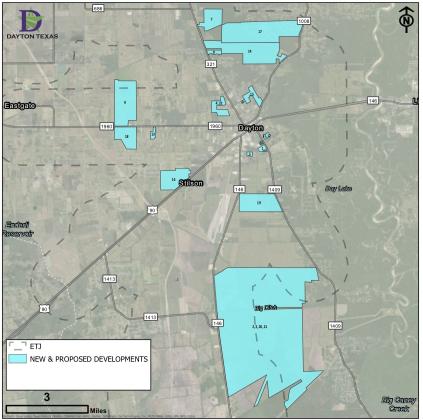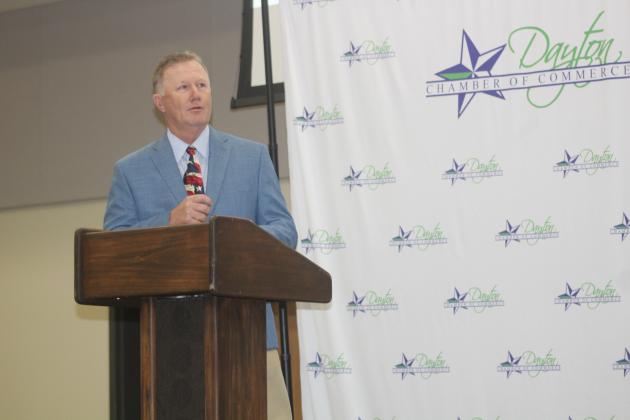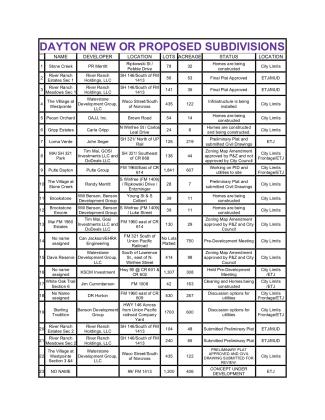Dayton projects over 27,000 new residents coming to area
DAYTON - Saying growth and change are coming to Dayton has become somewhat redundant, but with 23 developments in the works currently, it’s just around the corner.
Tuesday, City Manager Steve Floyd gave the annual State of the City Address to the Dayton Chamber. He spoke on the coming development, which will weigh heavily on city infrastructure soon.
“Currently, the city of Dayton does not have adequate infrastructure to serve all the new growth. However, with Impact Fees and future sales of service, we will be able to provide necessary services,” he told The Vindicator.
Current estimates have these developments taking around 10 years before total buildout would be complete; however, many are already underway.
Those 23 subdivisions will see around 8,200 new homes spread over 3,700 acres.
Projections of 3.4 people per household will bring that number to over 27,000 new residents either in the city or its Extraterritorial Jurisdiction, which Floyd praised past city councils for doing.
“Forward-thinking by past councils to do these strip annexations allows us to negotiate with developers to come into the city by voluntary annexation,” he said.
Those developers are on the way, and more are always inquiring.
“We have national developers like D.R. Horton and Pulte both securing property in the ETJ and we hope to get them over to the city limits soon,” said Floyd.
Those new subdivisions are scattered across the area. The city manager pointed out that the city limits resemble a spiderweb, which gives substantial control to the types of developments that come into the area. An area, he said, if circled, would match the size of Pasadena, which has a current estimated population of 152,537 people according to the 2020 Census.
Floyd believes there are both positives and negatives for Dayton as it continues to see growth.
“Positives are future revenue from property taxes and sales of services, water & Sewer and solid waste collection. Negatives are working to get the infrastructure in place to serve all the growth with limited funds,” he said.
He also laid out some vital development tools at the city’s disposal, like Public Improvement Districts (PID) and Tax Increment Reinvestment Zones (TIRZs).
He believes both are important and can help Dayton manage its growth and choose what the city will look like down the road.
He believes the most valuable of these is the PID.
“We can use this as a tool to incentivize developers to voluntarily annex in the city limits, whereas we can sell them services such as water and sewer and also collect property taxes,” he said.
As for the TIRZs, the city can be used by the city to attract new investment in the area and promote growth in areas that would otherwise not attract market development in a timely manner, according to Floyd.
He also pointed to another form of development, pointing to the use of Municipal Utility Districts (MUD) by developers, such as River Ranch. Floyd pointed out that MUDs have their own infrastructure while increasing traffic and congestion in the area, which takes away from the city coffers.
“I’m not a MUD fan. I’d prefer a PID, whereas the city generates revenue from the sale of services and also collects taxes,” he said.
Floyd also pointed to economic development growth on the commercial front, pointing to the work being done at Gulf Inland Logistics to bring in industry.
He also pointed to several other business sectors expressing interest in Dayton, like battery manufacturers, green energy recyclers, solar farm developers, industrial storage, and rail storage facilities.
Floyd believes this development will allow Dayton to improve its current situation, which was encountering a $5.2 million shortfall following the mismanagement of past city officials.
He also praised his staff, especially Finance Director Calyn Wesson and Kimberly Judge, for everything they do to help manage the growth and its moving parts.
“All this new development is tough to keep up with,” said Floyd.
Floyd also told chamber members that the city would be trying to sell DayNet in the future because it was just not feasible for the city, plus that the City Landfill would be closing at the end of the year.




